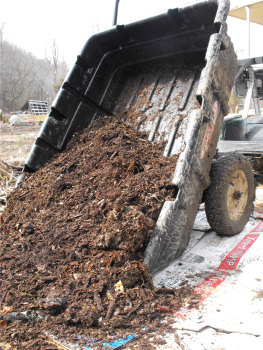
Different mulches for bacteria and fungi
 So
how do we build vegetable gardens with soil dominated by bacteria while
creating fungi-dominated soil around our trees? The first step is
to start being more sophisticated about our mulch choices.
So
how do we build vegetable gardens with soil dominated by bacteria while
creating fungi-dominated soil around our trees? The first step is
to start being more sophisticated about our mulch choices.
Bacteria are good at
breaking down what composters like to call
"greens" --- grass clippings, food scraps, and even straw (since the
grain was cut while it was still growing and full of sugars.)
Bacteria also thrive on easy to digest manures. On the other
hand, fungi shine when given "browns" --- fallen leaves, wood chips,
and anything else full
of lignin and hard for most other organisms to
digest.
The consistency and
application method of the mulch matters too.
Wet, finely ground mulch supports bacteria, even if the mulch consists
of fallen leaves. On the other hand, dry mulch in big chunks will
encourage fungi. Any mulch that is worked into the soil will feed
bacteria first, while mulch placed on the soil surface will feed fungi.
So an optimal mulch for
a vegetable or annual flower garden would
probably consist of finely chopped, wet grass clippings. Under
our trees, the best mulch would be big chunks of leaves or wood chips.
| This post is part of our Teaming With Microbes lunchtime series.
Read all of the entries: |
Want more in-depth information? Browse through our books.
Or explore more posts by date or by subject.
About us: Anna Hess and Mark Hamilton spent over a decade living self-sufficiently in the mountains of Virginia before moving north to start over from scratch in the foothills of Ohio. They've experimented with permaculture, no-till gardening, trailersteading, home-based microbusinesses and much more, writing about their adventures in both blogs and books.
Want to be notified when new comments are posted on this page? Click on the RSS button after you add a comment to subscribe to the comment feed, or simply check the box beside "email replies to me" while writing your comment.
